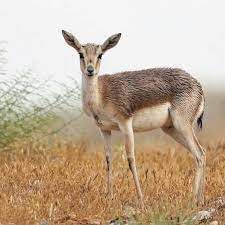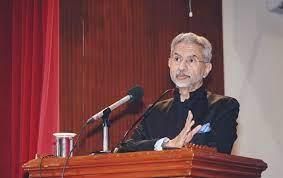Weekly Current Affairs (8th to 14th February 2024) | General Test Preparation for CUET UG - CUET Commerce PDF Download
What are Dzuds in Mongolia?
What are Dzuds?
- Dzuds are extreme winters unique to Mongolia characterized by freezing temperatures, heavy snow and frozen ground that prevents animals from reaching pasture. They often follow dry summers when livestock are unable to build up fat reserves.
- According to the UN Economic and Social Commission for Asia and the Pacific (ESCAP), the frequency and intensity of dzuds have increased since 2015 due to worsening climate change impacts and poor environmental governance.
- This winter’s dual “white” and “iron” dzud involves deep snow cover preventing animal access to grass (white dzud) and a freeze-thaw cycle that turns pastures to ice (iron dzud). Herding and livestock are integral to Mongolia’s economy, culture and lifestyle, with over 64 million animals affected this winter.
Impacts on Children
- Over 258,000 people, including over 100,000 children, have been impacted as heavy snow obstructs roads, limiting access to health, nutrition, education and social services.
- Herder families often leave children with relatives or at boarding schools, increasing risks and psychological stress.
Response Efforts
- The Government activated its Emergency Operations Center (EOC) and designated leadership to coordinate response. UNICEF dispatched health, hygiene and child protection kits to provinces and is procuring more supplies.
- Portable audio devices with lessons will be distributed to ensure remote learning. The UN calls for urgent humanitarian assistance and sustainable solutions to support rural communities.
Gupteswar Forest in Odisha declared Biodiversity-Heritage Site
What are Biodiversity-Heritage Sites (BHS)
- Under Section 37 of India’s 2002 Biological Diversity Act, State Governments may designate unique and fragile ecosystems as Biodiversity Heritage Sites (BHS) in consultation with local governing bodies.
- BHS may be terrestrial, coastal, inland water, or marine areas exhibiting rich biodiversity, including: abundance of wild and domesticated species; high endemism; rare and threatened species; keystone or evolutionarily significant species; wild ancestors of cultivated varieties; fossil beds denoting past biological importance; and significant cultural, ethical or aesthetic value. BHS maintain cultural diversity alongside, in some cases, a long history of human habitation.
Biodiversity of Gupteswar Forest
- The biodiversity inventory and survey conducted by the Odisha Biodiversity Board shows the presence of rich flora and fauna in the area. This includes at least 608 faunal species such as 28 mammal species, 188 bird species, 18 amphibian species, 48 reptile species, 45 fish species, and 141 butterfly species.
- Significant faunal species documented here include mugger crocodile, kanger valley rock gecko, sacred grove bush frog, black baza, Jerdon’s baza, Malabar trogon, and white-bellied woodpecker among others. The limestone caves of Gupteswar harbor eight bat species out of the total 16 found in southern Odisha. Two species – Hipposideros galeritus and Rhinolophus rouxii – are classified as near-threatened.
- The site has abundant floral diversity as well with 182 tree species, 76 shrub species, 177 herb species, 69 climber species, 14 orchid species and threatened medicinal plants. Many agriculturally and industrially important microorganisms also exist in this ecosystem.
Conservation and Development
- Declaration of Gupteswar as a BHS will boost conservation of biodiversity while also strengthening cultural connections of local communities. The Odisha government has allocated Rs 35 lakh for preparing a conservation action plan and community awareness activities. Eco-tourism and non-timber forest products can support local livelihoods.
- Overall, this declaration as a BHS will lead to improved conservation of the precious biodiversity of Gupteswar Forest. Odisha now has four BHSs with earlier declarations of biodiversity rich areas like Mandasaru, Mahendragiri and Gandhamardan.
State of the World’s Migratory Species – 2024 Report
- It provides the first comprehensive global assessment on the conservation status and threats facing migratory animals.
- The report finds that while some species are improving, nearly half of CMS-listed migratory species are declining and more than one-fifth are threatened with extinction.
Key Findings
The report reveals several concerning trends for migratory species:
- Nearly half of CMS-listed species are showing population declines
- More than one-in-five are threatened with extinction
- 97% of CMS-listed fish are threatened
- Extinction risk is growing globally even for non-CMS listed migratory species
- Overexploitation and habitat loss are the top threats facing migratory species
Recommendations
To address these threats, the report provides several recommendations, including:
- Increase protection of key habitats and migratory routes
- Address species most at risk of extinction
- Tackle climate change, pollution, and invasive species
- Expand conservation efforts to migratory species not currently protected
Hope for Recovery
While many migratory species face severe threats, the report also shows recovery is possible through coordinated conservation efforts. Examples include:
- Illegal bird netting reduced 91% in Cyprus
- The Saiga Antelope brought back from brink of extinction in Kazakhstan
Call for Action
- The report issues an urgent call to action for stronger policies and conservation efforts worldwide to protect migratory species.
- Key priorities include reducing unsustainable use, protecting key sites, addressing endangered species, and tackling climate change and pollution. International cooperation is critical, as migratory species cross borders and depend on multiple countries working together.
About the Convention
- The Convention on Migratory Species (CMS) is an environmental treaty focused on conserving migratory animals globally.
- It provides a platform for countries to coordinate conservation efforts for terrestrial, marine and avian migratory species. Since 1979, CMS membership has grown to 133 countries working together to sustainably manage migratory wildlife.
Australia’s Closing Loopholes Bill
Background
In 2023, Australian employers saw major industrial relations changes, including amendments to the Fair Work Act, new rights and protections, and additional compliance obligations. Further reforms were introduced in late 2023 and early 2024 through the Fair Work Amendment (Closing Loopholes) Act (December, 2023) and the Fair Work Legislation Amendment (Closing Loopholes No. 2) Bill, which has been recently passed in February, 2024.
Key Changes
The bill makes five key changes to Australian workplaces:
Right to Disconnect
- The bill creates a new right for employees to disconnect from work emails and calls during personal unpaid time.
- Employees can complain to employers about unreasonable out-of-hours contact. If unresolved, the Fair Work Commission can order employers to stop the contact. Fines of up to $18,000 apply for breaches. Some reasonable out-of-hours contact is still allowed, like for on-call employees.
Gig Economy
- The bill allows the Fair Work Commission to set minimum standards in the gig economy, like minimum wages, superannuation and insurance.
- This applies to digital platform workers with low bargaining power and authority over their work. Amendments mean workers must meet two of three criteria to be covered. Estimates suggest the changes could deliver $404 million per year in increased wages.
Casual Conversion
- The bill makes it easier for casuals working regular hours to convert to permanent roles. A single pathway is created for casuals to choose to convert.
- Employers can refuse on fair grounds. This abolishes the requirement for employers to offer conversion.
Enterprise Bargaining
- The Fair Work Commission can now arbitrate stuck enterprise agreements. A Greens amendment means arbitrated outcomes must be no less favourable than existing deals.
- This aims to encourage wage rises without new agreements.
Road Transport
- The Fair Work Commission can set minimum pay rates for independent contractor owner-drivers. A majority owner driver committee will advise on minimum road transport standards.
Right of Entry
- The bill expands union right of entry without notice to investigate suspected wage underpayment of members. Amendments require reasonable evidence of underpayment.
- The bill aims to close loopholes and strengthen worker rights and pay. But employer groups have raised concerns about increased union power and penalty rates.
What can India learn?
- The proposed Australian “Closing the Loopholes” Bill would provide important rights for gig workers. A key provision is the right to disconnect – gig workers could refuse to work during off hours, holidays and weekends simply by logging off the app.
- Uber has praised this initiative. India could follow Australia’s lead in providing protections once the law is passed. Europe has already recognized the right to disconnect.
- For gig workers, the model provides flexibility and the ability to use existing assets productively, without being tied to a single employer. However, they can feel pressured to be constantly “on call.” Doctors may have to respond to urgent hospital calls at odd hours. In tech, employees “moonlighting” as gig workers raises ethical issues. The most honorable path is to openly declare freelance status.
7th Indian Ocean Conference
Indian Ocean Region
- The Indian Ocean Region (IOR) is a geographical region encompassing the Indian Ocean and surrounding areas. It spans from the African coast in the west to the Australian coast in the east. The northern boundary includes the Arabian Peninsula and Persian Gulf.
- The southern boundary extends to the coasts of Sri Lanka and Australia. The Indian Ocean is the world’s third largest ocean, covering approximately 70.6 million square kilometers.
Significance of the IOR
- The IOR holds great geopolitical, economic, security and environmental significance. Its location makes it a major global trade transit route, including for oil and gas shipments. It contains strategically important chokepoints like the Strait of Malacca and Bab-el-Mandeb strait.
- The region shares 64% of global population and 60% of global GDP. It faces security threats like terrorism, piracy and maritime challenges. The IOR also contains vital marine ecosystems like coral reefs and mangrove forests.
Indian Ocean Conference (IOC)
- The Indian Ocean Conference (IOC) is an annual international event focused on the Indian Ocean region.
- It convenes policymakers, scholars, business leaders and civil society to discuss security, trade and cooperation in the region. The first IOC was held in Singapore in 2016. The sixth edition took place in Dhaka, Bangladesh in 2023. It is organized by the India Foundation and partners.
Key Highlights of EAM Jaishankar’s Speech
External Affairs Minister Dr. S. Jaishankar highlighted the following in his speech:
- Threats to maritime traffic, piracy and terrorism in the region. Concerns over freedom of navigation, sovereignty and independence.
- Disruptive events occurring more frequently due to climate change and natural disasters. Fuel, food and fertilizer crises affecting IOR countries.
- Challenges from unsustainable debt, opaque lending, unviable projects and injudicious choices.
- Over-concentration of manufacturing and technology due to globalization. Need to build reliable, resilient supply chains.
- The digital era and AI have increased the premium on trust and transparency.
- Sustainable future lies in digitalization, electric mobility, green hydrogen, green shipping and more.
Key Takeaways
The 7th IOC highlighted the IOR’s geopolitical significance. It covered traditional and non-traditional security threats in the region. The conference emphasized the need for greater cooperation to build a stable, sustainable Indian Ocean.
World Pulses Day – Current Updates (February, 2024)
2024 World Pulses Day Theme: Pulses: nourishing soils and people
World Pulses Day 2024 theme is “Pulses: nourishing soils and people”. It highlights the advantages of cultivation of pulses to not only nutritional security of people but also healthy soil.
About Pulses
Pulses refer to the edible seeds of legume plants like beans, lentils, and peas. They are nutrient-dense and feature prominently in global cuisines. Pulses are distinct from other legumes due to their exclusion of green-harvested and non-food crops. Their nutritional value and sustainable production make them vital for food security and health.
Advantages of Pulses
- Pulses are nutrient-dense, good source vitamins and minerals vital for health.
- Pulses have long shelf-life, increase diet diversity, reduce food loss and waste.
- Pulses grow in multiple cropping systems, enhance agrobiodiversity, climate resilience, ecosystem services.
- Pulses fix nitrogen into soil, improve soil biodiversity and fertility.
- Pulses in crop rotations improve chemical fertilizer efficiency.
- Pulses provide employment and opportunities for rural women and youth.
The Significance of Pulses
Pulses provide multiple benefits that make them indispensable:
- As plant-based sources of protein, fiber, vitamins and minerals, they combat malnutrition and promote health.
- Their ability to fix nitrogen enriches soils, reduces synthetic fertilizers, and promotes water-efficient farming.
- They offer an affordable protein source that supports food security and incomes of smallholder farmers.
- Their low carbon footprint and biodiversity benefits make pulses crucial for environmental sustainability.
Global Celebrations
World Pulses Day serves to:
- Raise awareness about the health and nutritional benefits of pulses.
- Highlight pulses’ contribution to sustainable agriculture and soil health.
- Support economic opportunities for pulse farmers.
- Encourage research to improve pulse varieties and cultivation.
Pulses and Sustainable Development
Pulses are integral to sustainable development as they provide solutions to challenges like food insecurity, malnutrition, environmental degradation, and climate change. By nourishing soils and people, pulses exemplify agricultural sustainability that aligns ecological health with human well-being.
Pradhan Mantri Matsya Kisan Samridhi Sah-Yojana (PM-MKSSY)
Key Features
Investment and Duration
- The scheme will be implemented from FY 2023-24 to FY 2026-27 in all States/Union Territories with an estimated outlay of Rs. 6,000 crore.
- 50% of the investment will be public finance and 50% is expected from the private sector.
Beneficiaries
- The scheme targets fishers, fish farmers, fish vendors, micro and small enterprises, cooperatives, self-help groups, and other entities engaged in fisheries value chains.
Objectives
- To create a digital platform for registering 40 lakh micro and small fisheries enterprises.
- To facilitate institutional credit access for 6.4 lakh micro-enterprises and 5,500 cooperatives.
- To shift from subsidies to performance-based incentives.
- To improve value chain efficiency and ensure safe, quality fish.
- To promote sustainability and ease of doing business.
- To provide insurance coverage against crop losses.
- To enhance export competitiveness through value addition.
Major Components
- Formalization of the sector through a digital platform.
- Facilitating aquaculture insurance adoption.
- Performance grants to improve value chain efficiencies.
- Grants for adopting safety and quality assurance systems.
- Project monitoring and management.
Expected Impact
- 7 lakh new jobs will be created with a focus on women employment.
- Enhanced incomes due to value chain efficiencies and profit margins.
- Improved quality and safety standards in domestic fish market.
- Empowerment of women through job creation and safe workplaces.
Background
- The fisheries sector has seen growth in production and exports from 2013-14 to 2022-23. However, challenges like informality, lack of insurance, poor credit access, and quality issues persist. The new scheme aims to address these issues with a total outlay of Rs. 6,000 crore.
Bharat Ratna conferred on Former Prime Ministers Narasimha Rao, Charan Singh and Agricultural Scientist MS Swaminathan
PV Narasimha Rao: The Architect of India’s Economic Reforms
- The late PV Narasimha Rao served as the ninth Prime Minister of India from 1991-1996. He is widely credited as the architect of India’s economic liberalization in the 1990s.
- Rao adopted policies that opened the Indian economy to global markets by dismantling the license-permit raj system. His visionary leadership and reforms ended the ‘License Raj’ and paved the way for foreign investments into India.
- Rao fostered a new era of economic development that laid a solid foundation for India’s future economic growth and prosperity.
- Rao pursued pragmatic foreign policy, boosting ties with US and Israel while stabilizing relations with China and Pakistan. Forged ‘Look East‘ policy with ASEAN nations.
Chaudhary Charan Singh: A Staunch Advocate for Farmers’ Rights
- Former Prime Minister Chaudhary Charan Singh is being honored with the Bharat Ratna award posthumously for his unwavering commitment and invaluable contributions to the welfare of farmers in India.
- Singh served as the Chief Minister of Uttar Pradesh twice and held several important portfolios at the national level, including Finance Minister and Home Minister.
- However, he is best remembered as a champion of farmers’ rights and interests. Throughout his prolific political career, Charan Singh strongly advocated for the rights and welfare of the farmers. He was instrumental in implementing several pioneering initiatives for agriculture reforms and farmer prosperity. His birth anniversary is celebrated as Kisan Diwas or National Farmers Day.
- His dedicated efforts for ensuring fair prices, timely loan waivers, and income security for farmers earned him widespread popularity among the farming communities across North India.
MS Swaminathan: The Father of India’s Green Revolution
- Renowned agricultural scientist M.S. Swaminathan has been honored with India’s highest civilian award for his instrumental role in pioneering the Green Revolution in India.
- In the 1960s, Swaminathan implemented new technology and innovations in agriculture that transformed India’s food security situation. His introduction of high-yielding seeds, modern irrigation techniques, and optimal use of fertilizers led to a remarkable increase in crop productivity.
- This averted the frequent famines and acute food shortage at that time. Swaminathan’s research and fieldwork made India self-sufficient in food grain production within a few years.
- For his monumental contributions that made India food secure, he earned the title ‘Father of Green Revolution’. Swaminathan dedicated his life to agricultural advancement by promoting environmentally sustainable practices. As a scientist, he helped modernize Indian agriculture and mentored countless students.
Fentanyl Crisis in Mexico
Official Responses
- Mexican President Andrés Manuel Lopez Obrador has downplayed the fentanyl problem, claiming Mexico doesn’t produce or consume it. Following backlash, he promised new legislation to ban fentanyl and other synthetic opioids.
- However, those on the frontlines in Tijuana fear it’s too little, too late. Across the border, some US Republicans advocate sending troops into Mexico to fight the cartels. But given how easily fentanyl can be transported, stemming the flow into the US is extremely difficult.
Scale of the Crisis
- In Tijuana, the director of state forensic services says 1 in 3 bodies tested positive for fentanyl in July 2022. The closer to the US border, the more fentanyl is found. The extent nationwide is unknown.
- Harm reduction centers in Tijuana have evidence too, with all randomly tested needles and vials positive for fentanyl. The center’s director says ignoring the problem won’t solve it and people will keep dying. In the US, around 70,000 overdose deaths involved fentanyl in 2021. In Texas alone, over 5 deaths occur daily.
Impact on Families
- Fifteen-year-old Elijah Gonzales, from El Paso, accidentally overdosed on a fentanyl-laced fake Xanax pill, likely his first time taking drugs.
- Texts suggest he didn’t know it contained fentanyl. His mother Nellie Morales says a piece of her died with Elijah and she misses him every day. Such stories are tragically common across the US.
Role of Drug Cartels
- Seventeen-year-old cartel member Kevin smuggles fentanyl into the US through border tunnels. He says cartels earn around $200,000 per kilo in the US, paying smugglers like him $1000 per run.
- Kevin predicts fentanyl will keep growing as the strongest drug he’s seen, with users demanding more and more. He feels no remorse over US deaths, calling it “part of a chain” where “everyone’s responsible for their own acts.”
Ongoing Crisis
- In Tijuana, paramedics revived one overdose victim with multiple Narcan doses but his friend died amid empty glasses at the bar.
- As the man’s mother arrives and learns of his death at 27, her wails pierce the barroom. He is just another casualty of this powerful narcotic, as the epidemic continues on both sides of the US-Mexico border.
EC Recognizes Ajit Pawar’s Faction as NCP
EC’s Role in Settling Disputes over Party Symbols
- The Symbols Order, 1968 empowers the ECI to decide on claims of rival factions in case of a party split. Such disputes are decided as per the Symbols Order.
- This rule applies to disputes in recognised national and state parties, as the election symbol is seen as the identity of the party. The ECI usually advises unrecognised party factions to resolve differences internally or approach the court. The ECI’s decision is binding on rival groups.
Criteria Used by ECI
- The ECI generally uses three tests outlined in the Sadiq Ali case – the party’s aims/objectives, party constitution, and test of majority.
- For the majority test, it sees the support within the legislative and organisational wings. In recent cases, when organisational support was unclear, the ECI relied solely on majority amongst elected MPs and MLAs. If both tests are inconclusive, the ECI freezes the symbol.
Implications for Splinter Group
- Before 1997, the breakaway faction was recognised as a separate party if it met the criteria. Since 1997, the splinter group has to register as a new party and can claim national/state party status only based on post-registration electoral performance.
Background of NCP Dispute
- The split in NCP occurred when Ajit Pawar joined hands with the BJP-Shiv Sena alliance in Maharashtra in 2022. Both factions sought recognition from the ECI.
- The ECI started hearings in July 2022 and gave its verdict in February 2023.
EC’s Verdict and Basis of Decision
- The ECI ruled that the Ajit Pawar faction is the real NCP based on the test of majority in the legislative wing. Of NCP’s total 81 MPs/MLAs/MLCs, 57 supported Ajit Pawar while 28 backed Sharad Pawar.
- The ECI rejected the organisational wing test as internal elections lacked basis. It asked the Sharad Pawar faction to choose a new name and symbol.
|
164 videos|800 docs|1156 tests
|

























